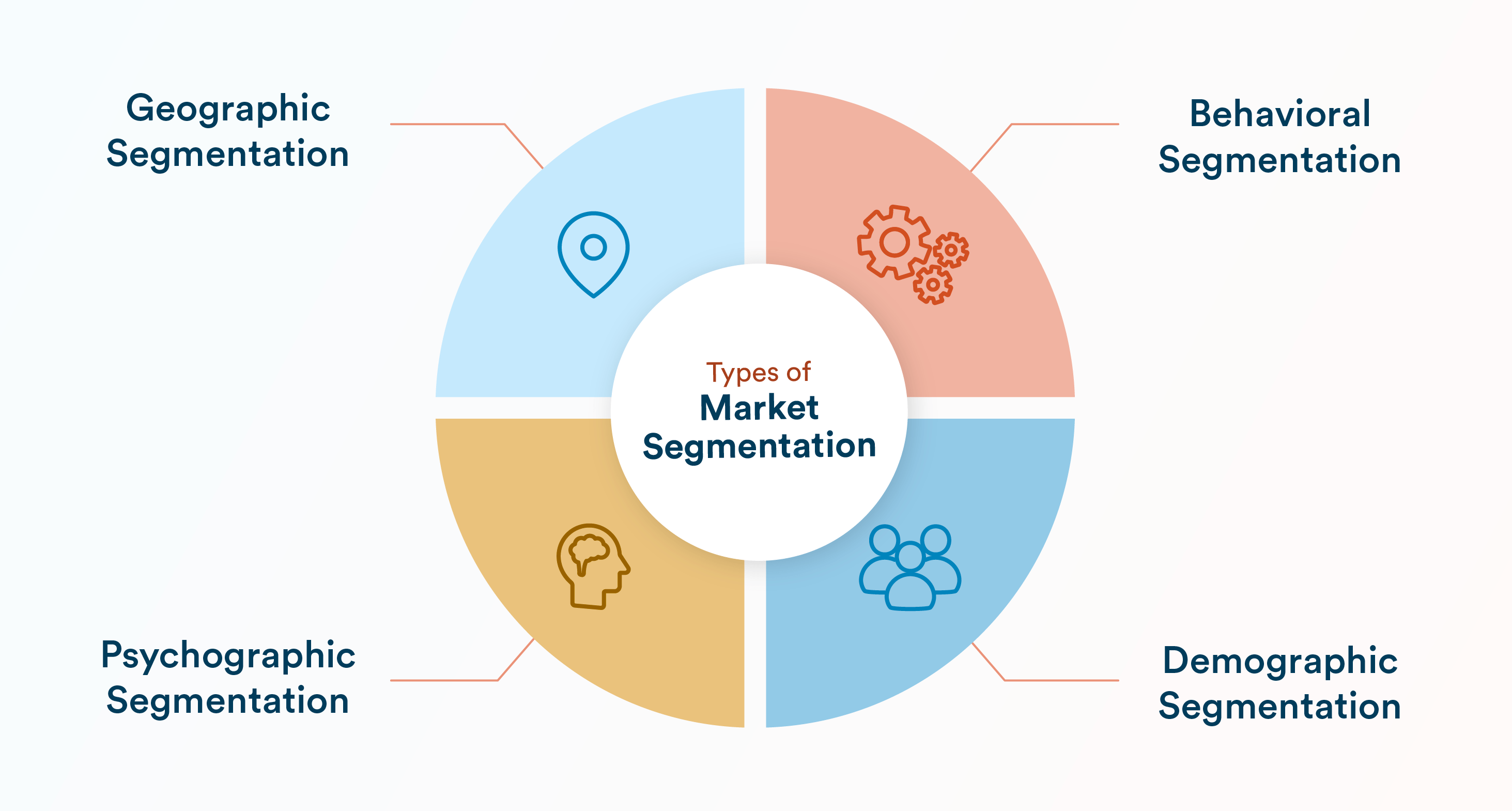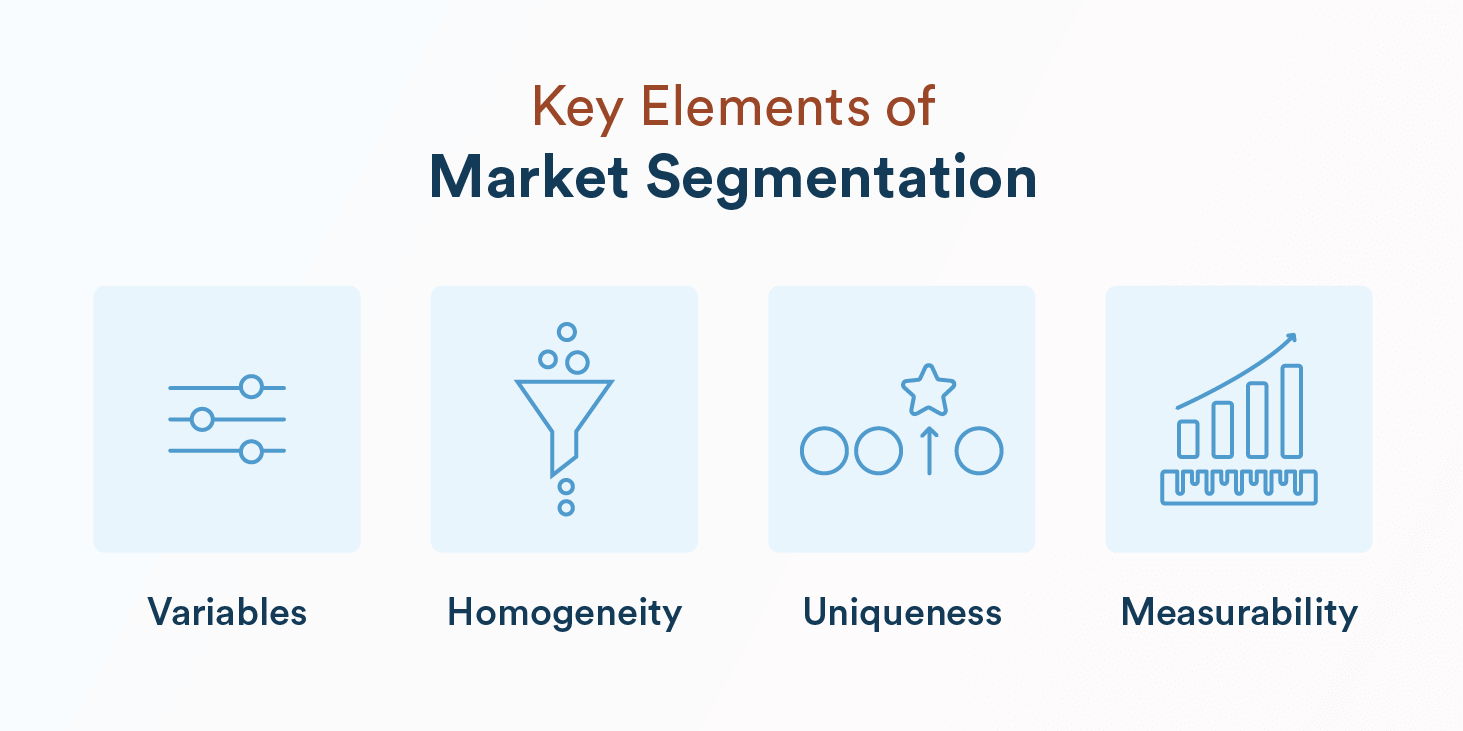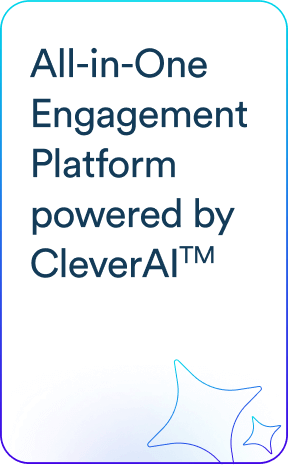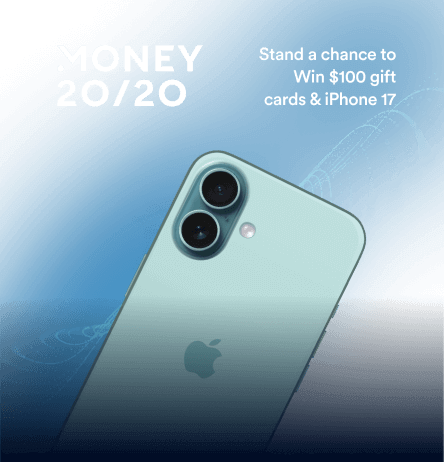Target market and market segmentation are foundational marketing concepts that are closely related yet distinct. This blog breaks down these concepts and explores their similarities and differences in detail.
If you’re a marketing professional, you probably use terms like target market and market segmentation on a daily basis. But, for someone who is new to marketing, these terms might sound similar and quite confusing.
Understanding Market Segmentation & Its Role in Marketing Strategy
Market segmentation is a powerful tool that allows marketers to effectively target the right audience of their product with the right message. Let’s delve into it.
What is Market Segmentation?
Market segmentation is the process of segregating customers into distinct groups based on common characteristics, behaviors, needs, and preferences. Broadly speaking, you can divide your customer base into the following types of market segmentation:
- Demographic Segmentation: This involves segmenting customers based on their age, gender, income, occupation, family structure, etc.
- Geographic Segmentation: This divides the customer base based on their physical location, time zone, climate, language nuances, cultural considerations, and other such factors.
- Behavioral Segmentation: This involves creating customer groups based on their buying behavior, feature use, spending habits, session frequency, and similar attributes.
- Psychographic Segmentation: This involves creating segments based on lifestyle, preferences, personality traits, etc.

Market segmentation is important to identify customer groups that are most relevant and unique to your business, and then target them with more tailored and personalized marketing campaigns and communications, which can have a higher probability of conversion. For example, an athletic/sports shoe maker would want to segment its customers by age, professional players, people with health issues, gym goers, and so on.
Key Elements
Before you start off the process of market segmentation, it is essential to understand the key elements of customer segmentation that would make the most sense. If this is not clear, chances are that your segmentation strategy might fall apart.
The key elements of market segmentation include:
- Variables: These are the factors that are used to create the customer segments – the common traits that are shared by people such as demographic, geographic, behavioral, and psychographic.
- Homogeneity: This is an essential element to keep in mind as unless a segment is homogenous, meaning their needs and preferences are aligned, the strategy to target them with personalized messaging won’t work.
- Uniqueness: Each segment should be unique, distinct, and relevant to your offering and business.
- Measurability: It is important to know the number of customers in a segment and their purchasing power to determine if it is worth devising marketing campaigns for it. This can further enable marketers to understand what initiatives to undertake to grow a segment if it’s most relevant but small in size.

Benefits
When done right, market segmentation can engender a number of benefits for marketers:
1. Improved Product and Business Relevance
The process of creating smaller customer segments unlocks key insights into the needs, preferences, and behavior of customers, enabling businesses to align their products and features accordingly. Furthermore, this helps devise personalized marketing campaigns that resonate with what customers are looking for and have better chances of conversion.
2. Better Targeting
Implementing market segmentation effectively enables crafting targeted marketing campaigns – targeting the right people at the right time with the right message. This has a higher chance of conversion than the generic spray and pray campaigns and can help optimize ad spend.
3. Enhanced Engagement and Loyalty
Market segmentation enables you to drive customer outreach campaigns based on what they are seeking. This personalized approach goes a long way in cultivating meaningful customer relationships, boosting their satisfaction and loyalty, and improving customer lifetime value.
4. Higher Return on Investment
Market segmentation not only helps marketers optimize their budget spend but also enables the overall business to understand the overarching trends gradually – which segments are most profitable, which campaigns worked, which segments are underserved but have high conversion potential, and more. These insights can help businesses strategize better and ensure a higher return on investment.
5. Well-Informed Decision-Making
It is customer data that underpins an effective and sound market segmentation strategy. Analyzing the data helps bring method to the madness in making strategic business decisions such as product development, pricing, promotional strategy, distribution channels, and more.
Target Markets: How to Choose the Right Audience
Once a brand identifies market segments, the next step is to identify and select the target markets for driving marketing efforts. Let’s understand how.
What is a Target Market?
A target market is a group of customers with a high potential for conversion when pursued with tailored marketing campaigns. This group usually has some shared characteristics, such as age, gender, education, income, interests, or location, which bring homogeneity in their needs and preferences, making them ideal for a targeted marketing strategy.
So, it could be said that market segmentation is the process of identifying and creating a target market. Building on the previous example of a sports shoe maker, the “gym goers” segment can include men and women who are above 18 years of age and could be targeted with messages centered on lightweight, comfort, durability, and style.
How are Target Market and Market Segmentation Related?
Market segmentation and target market could be regarded as the two sides of the same personalized marketing coin. Both work together to help you drive effective tailored and targeted marketing campaigns.
Here’s how market segmentation and target market are related:
- Purpose: These are both essential aspects of developing effective, targeted, and personalized marketing campaigns and communications.
- Relationship: While market segmentation is the process of identifying and creating distinct and relevant customer groups, target markets are the groups that have been selected for pursuing targeted marketing campaigns.
- Benefits: Both market segmentation and target market go hand in hand to help a business improve its customer outreach efforts and conversions, optimize marketing budget spend, and strengthen customer retention and loyalty by aligning its product and messaging to what they are looking for.
Examples of Successful Target Marketing
Targeted marketing is the process of focusing on a specific group or customer segment to market a product or service. The objective is to pursue customers who are more likely to be interested in the product or service and make a purchase.
For example, global footwear and apparel giant Nike targets a broad market segment comprising people from 15 to 60 years of age. While it has products ranging from low to high price points, the company offers limited edition shoes, such as Air Jordan V El Grito, Air Jordan 1 Low – Travis Scott x Fragment, and Air Jordan 1 ‘Next Chapter,’ to “sneaker enthusiasts” who actively and consistently purchase these rare and exclusive shoes to add to their collection.
Market Segmentation vs. Target Markets: How are They Different?
The difference between market segmentation and target market basically emanates from their scope, purpose, and objectives. Let’s look at their differences in detail.
| Market Segmentation | Target Market | |
| Definition | It is the process of dividing customers into smaller groups or segments from the larger customer base. | It is the process of selecting particular customer segments for personalized marketing campaigns. |
| Objective and Purpose | It helps in providing a comprehensive overview of the customer segments defined by their common characteristics. | It helps in identifying specific segments that are more likely to be interested in a product or service and make a purchase.
|
| Focus
| It is focused on creating customer segments based on factors such as age, gender, income, education, personality traits, interests, buying behavior, or location. | It is focused on selecting the most promising segments based on factors such as segment size, profitability, and alignment with the overall business and marketing strategy. |
| Data Analysis | It involves collecting and analyzing customer data to create customer segments. | It leverages data analysis to help identify the best segments for personalized marketing campaigns. |
| Marketing Efforts and Strategy | It helps ensure the relevance and effectiveness of marketing efforts by providing insights into potential customer segments, underserved or overlooked segments, and more. | It helps boost customer retention and loyalty by enabling marketers to align and fine-tune their messaging and marketing campaigns with customer needs and preferences. |
| Performance Evaluation | It enables marketers to evaluate the effectiveness of marketing strategies by monitoring the response to various marketing activities across segments. | It helps evaluate the effectiveness of marketing strategies for the targeted segments and understand ROI to keep refining the strategy. |
Why Combining Target Marketing and Market Segmentation is Essential
It is essential for businesses to adopt and implement an integrated framework that combines market segmentation and target marketing. These two processes work together to unlock insights into the effectiveness of marketing strategies, understand gaps and blind spots, and maximize the impact and ROI.
Together, market segmentation and target marketing can help you:
- Drive personalized marketing campaigns that are tailored to the needs and preferences of the target customers.
- Boost conversion rates and business revenue by aligning product development and innovation roadmap with what customers are looking for.
- Enhance customer satisfaction and loyalty by crafting personalized communication that “speaks” to them.
- Increase sales and profits by ensuring optimum allocation of resources and optimizing marketing campaigns for maximum impact and ROI.
Real-World Target Market and Market Segmentation Example
Let’s understand market segmentation and target markets with the help of a real-world example.
Consider the leading café giant Starbucks. Its ideal customer profile includes males and females residing in urban and suburban areas and in the age group of 22-60 years. Its target market is the affluent – middle and upper class – comprising of individuals who are educated, active, and socially aware.
Here are the four key market segmentation pools:
Demographic
- Age: 22-60 years.
- Gender: Male and Female.
- Income: Middle and upper-class people, earning over $100,000 annually.
Geographic
- Location: Urban and sub-urban areas.
Behavioral
- Starbucks’ customer base is largely loyal with many of them making purchases every day.
- The company launched a rewards program in 2019 to further boost customer loyalty. The point-based system has proved to be extremely successful.
Psychographic
- Personality Traits: Affluent, professionally driven, environmentally and socially aware people.
- The company was one of the first café chains that offered free WiFi to in-store customers.
- The company launched a reusable cup program to position itself as a sustainability-conscious brand.
Over the years, Starbucks has established itself as a premium café chain. Getting a Starbucks cup with your name written on it was quite a rage a few years ago. But it doesn’t stop there. The company is forward-looking and keeps adapting to evolving customer tastes and preferences in an agile manner. From vegan coffees and food choices and environment-friendly positioning to launching its own app and rewards program, the company’s strategy to stay ahead of the curve is noteworthy.
Building an Integrated Market Segmentation and Targeting Strategy
Here are the key steps that can help you build an integrated market segmentation and targeting strategy:
1. Define the Objective
The first step is to define the goal or the objective that you’re seeking to accomplish with the integrated framework – Is it raising brand awareness? Is it boosting the conversion rate? Is it identifying overlooked and underserved segments that have high success potential? Is it fostering stronger relationships with existing, loyal customers?
2. Identify Relevant Market
The next step is to identify your brand and product’s niche market in the broader target market. This is important to understand the scope of your outreach efforts.
3. Understand Your Customers
The success of the integrated approach is highly dependent on the quality and depth of customer data. Businesses need to collect customer data and drill down to understand their needs and preferences, interests, and buying behaviors.
4. Create Relevant Customer Segments
Group your potential customers into distinct and relevant segments aligned with your brand, product, and strategic objectives. This segmentation will provide insights into the most lucrative segments, underserved yet promising segments, and more.
5. Select Target Markets
Identify and choose the segments that are most likely to engender the objectives laid out in Step 1. This is a crucial step as it forms the basis for driving personalized marketing campaigns.
6. Develop Tailored Marketing Strategy
Craft personalized and tailored marketing campaigns and communication that resonate the most with the needs and preferences of target markets determined in Step 5.
How CleverTap Helps Brands Align Market Segmentation and Target Marketing
CleverTap helps businesses across industries adopt and implement the integrated approach to market segmentation and target marketing in a seamless and efficient manner. It enables brands to create various customer segments depending on their business requirements:
- Behavioral: Based on past behavior, real-time activity on an app or website, and common user properties, such as preferred language, customer type, geographic location, etc.
- Predictive: Based on intent-based segments and RFM analysis (recency, frequency, and monetary).
- Custom List: Based on third-party data that is ingested into CleverTap.
CleverTap also enables you to harness the power of AI to customer engagement with its Clever.AI segmentation model. You can leverage Clever.AI to set engagement goals and understand the probability of achieving those goals.
To learn more about how CleverTap can help you align market segmentation and target marketing, request a personalized demo today!
Conclusion
Target market and market segmentation are the very foundation of an effective marketing strategy. They complement each other and work together to help you reach the right customers with the right message to improve customer satisfaction and loyalty and boost conversion rates. Tools like CleverTap, with automated workflows and advanced AI-based features, empower you to get your target marketing strategy up and running quickly to boost business growth and revenue.
FAQs
What is the difference between a market segment and a target market?
A market segment is a group of customers that have certain common traits, such as age, gender, income, interests, buying behavior, location, etc. that are categorized for marketing initiatives while target markets are the most promising and relevant market segments for driving tailored and personalized marketing campaigns.
Why is market segmentation important for identifying a target market?
Market segmentation is important for identifying a target market because it provides valuable insights into the customers’ needs, preferences, and buying behavior, enabling marketers to develop better aligned marketing campaigns and communication.
What are the 4 target market segments?
The four main types of market segments are demographic, geographic, psychographic, and behavioral.
How do market segmentation and target marketing work together?
Market segmentation and target marketing work together to help brands identify the segments that are unique, relevant, and most promising for driving tailored marketing campaigns that can help improve conversion rates as well as customer satisfaction and loyalty.
Agnishwar Banerjee 
Leads content and digital marketing.Expert in SaaS sales, marketing and GTM strategies.
Free Customer Engagement Guides
Join our newsletter for actionable tips and proven strategies to grow your business and engage your customers.















































